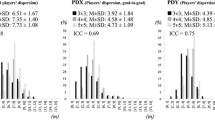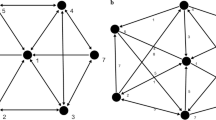Abstract
Quantitative analysis is increasingly being used in team sports to better understand performance in these stylized, delineated, complex social systems. Here, the authors provide a first step toward understanding the pattern-forming dynamics that emerge from collective offensive and defensive behavior in team sports. The authors propose a novel method of analysis that captures how teams occupy sub-areas of the field as the ball changes location. The authors use this method to analyze a game of association football (soccer) based upon a hypothesis that local player numerical dominance is key to defensive stability and offensive opportunity. The authors find that the teams consistently allocated more players than their opponents in sub-areas of play closer to their own goal. This is consistent with a predominantly defensive strategy intended to prevent yielding even a single goal. The authors also find differences between the two teams’ strategies: while both adopted the same distribution of defensive, midfield, and attacking players (a 4: 3: 3 system of play), one team was significantly more effective in maintaining both defensive and offensive numerical dominance for defensive stability and offensive opportunity. That team indeed won the match with an advantage of one goal (2 to 1) but the analysis shows the advantage in play was more pervasive than the single goal victory would indicate. The proposed focus on the local dynamics of team collective behavior is distinct from the traditional focus on individual player capability. It supports a broader view in which specific player abilities contribute within the context of the dynamics of multiplayer team coordination and coaching strategy. By applying this complex system analysis to association football, the authors can understand how players’ and teams’ strategies result in successful and unsuccessful relationships between teammates and opponents in the area of play.
Similar content being viewed by others
References
McGarry T, Applied and theoretical perspectives of performance analysis in sport: Scientific issues and challenges, International Journal of Performance Analysis in Sport, 2009, 9: 128–140.
Franks I, Use of feedback by coaches and players, Science and Football III (ed. by Reilly T, Bangsbo J, and Hughes M), E & FN Spon, London, 1997: 267–268.
Liebermann D, Hughes M, Bartlett R, McClements J, and Franks I, Advances in the application of information technology to sport performance, Journal of Sports Sciences, 2002, 20: 755–769.
Smith R and Loschner C, Biomechanics feedback for rowing, Journal of Sports Sciences, 2002, 20: 783–791.
Borrie A, Jonsson G, and Magnusson M, Temporal pattern analysis and its applicability in sport: An explanation and exemplar data, Journal of Sports Sciences, 2002, 20: 845–852.
Hristovski R, Davids K, Araújo D, and Passos P, Constraints-induced emergence of functional novelty in complex neurobiological systems: A basis for creativity in sport, Nonlinear Dynamics Psychology and the Life Sciences, 2011, 15: 175–206.
Passos P, Davids K, Araújo D, Paz N, Minguéns J, and Mendes J, Networks as a novel tool for studying team ball sports as complex social systems, Journal of Science and Medicine in Sport, 2011, 2: 170–176.
Davids K, Button C, Araújo D, Renshaw I, and Hristovski R, Movement models from sports provide representative task constraints for studying adaptive behavior in human movement systems, Adaptive Behavior, 2006, 14(1): 73–95.
Araújo D, Davids K, and Hristovski R, The ecological dynamics of decision making in sport, Psychology of Sport and Exercise, 2006, 7: 653–676.
Correia V, Araújo D, Craig C, and Passos P, Prospective information for pass decisional behavior in rugby union, Human Movement Science, 2011, 30(5): 984–997.
Esteves P, Oliveira R, and Araújo D, Posture-related affordances guide attack in basketball, Psychology of Sport and Exercise, 2011, 12: 639–644.
Passos P, Araújo D, Davids K, Gouveia L, Serpa S, Milho J, and Fonseca S, Interpersonal pattern dynamics and adaptive behavior in multiagent neurobiological systems: Conceptual model and data, Journal of Motor Behavior, 2009, 41(5): 445–459.
Passos P, Araújo D, Davids K, Gouveia L, Milho J, and Serpa S, Information-governing dynamics of attacker-defender interactions in youth rugby union, Journal of Sports Sciences, 2008, 26(13): 1421–1429.
Bangsbo J and Peitersen B, Soccer Systems and Strategies, Human Kinetics, Champaign, IL, 2000.
Di Salvo V, Gregson W, Atkinson G, Tordoff P, and Drust B, Analysis of high intensity activity in premier league soccer, International Journal of Sports Medicine, 2009, 30: 205–212.
O’Donoghue P and Robinson G, Validity of the Prozone3®, player tracking system: A preliminary report, International Journal of Computer Science in Sport, 2009, 8(1): 37–53.
Di Salvo V, Baron R, Tschan H, Montero F C, Bachl N, and Pigozzi F, Performance characteristics according to playing position in elite soccer, International Journal of Sports Medicine, 2007, 28(3): 222–227.
Travassos B, Araújo D, McGarry T, and Vilar L, Interpersonal coordination and ball dynamics in futsal (indoor football), Human Movement Science, 2011, 30: 1245–1259.
Vilar L, Araújo D, Davids K, and Travassos B, Constraints on competitive performance of attackerdefender dyads in team sports, Journal of Sports Sciences, 2012, 30(5): 459–469.
Bourbousson J, Seve C, and McGarry T, Space-time coordination dynamics in basketball: Part 1. Intra- and inter-couplings among player dyads, Journal of Sports Sciences, 2010, 28(3): 339–347.
Author information
Authors and Affiliations
Corresponding author
Additional information
The first author was supported by the Portuguese Foundation for Science and Technology (SFRH/BD/43251/2008).
This paper was recommended for publication by Editors FENG Dexing and HAN Jing.
Rights and permissions
About this article
Cite this article
Vilar, L., Araújo, D., Davids, K. et al. Science of winning soccer: Emergent pattern-forming dynamics in association football. J Syst Sci Complex 26, 73–84 (2013). https://doi.org/10.1007/s11424-013-2286-z
Received:
Revised:
Published:
Issue Date:
DOI: https://doi.org/10.1007/s11424-013-2286-z




